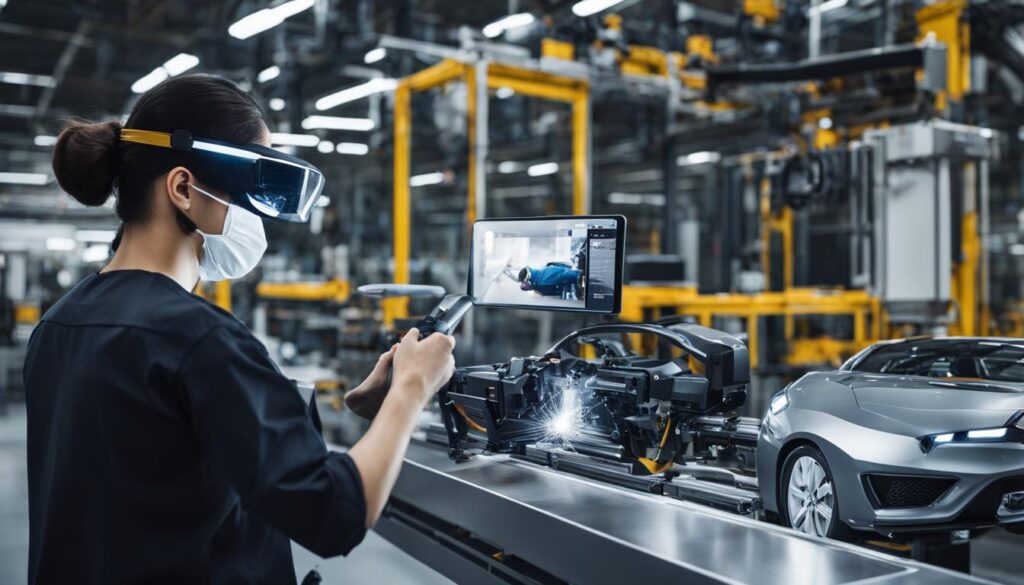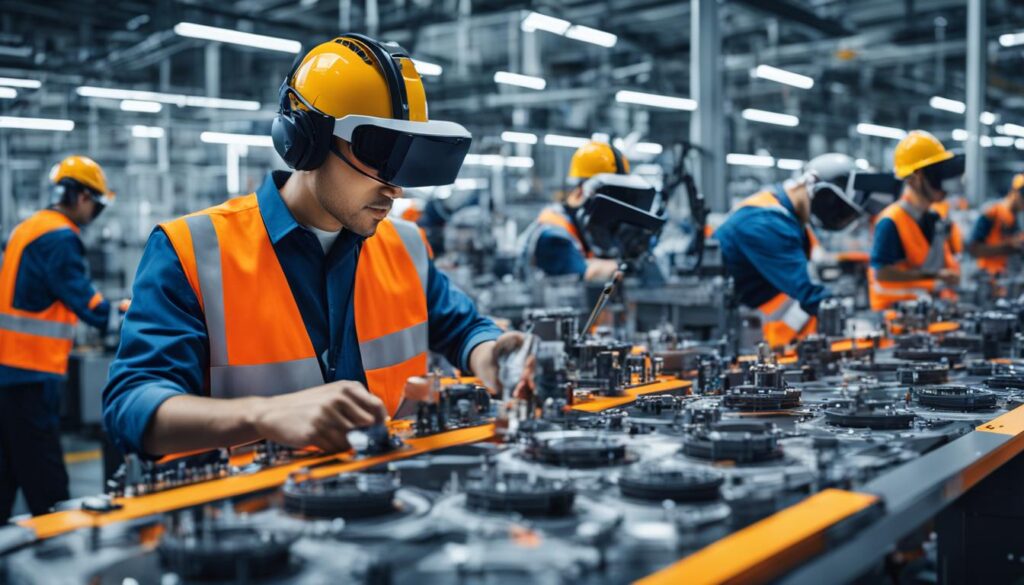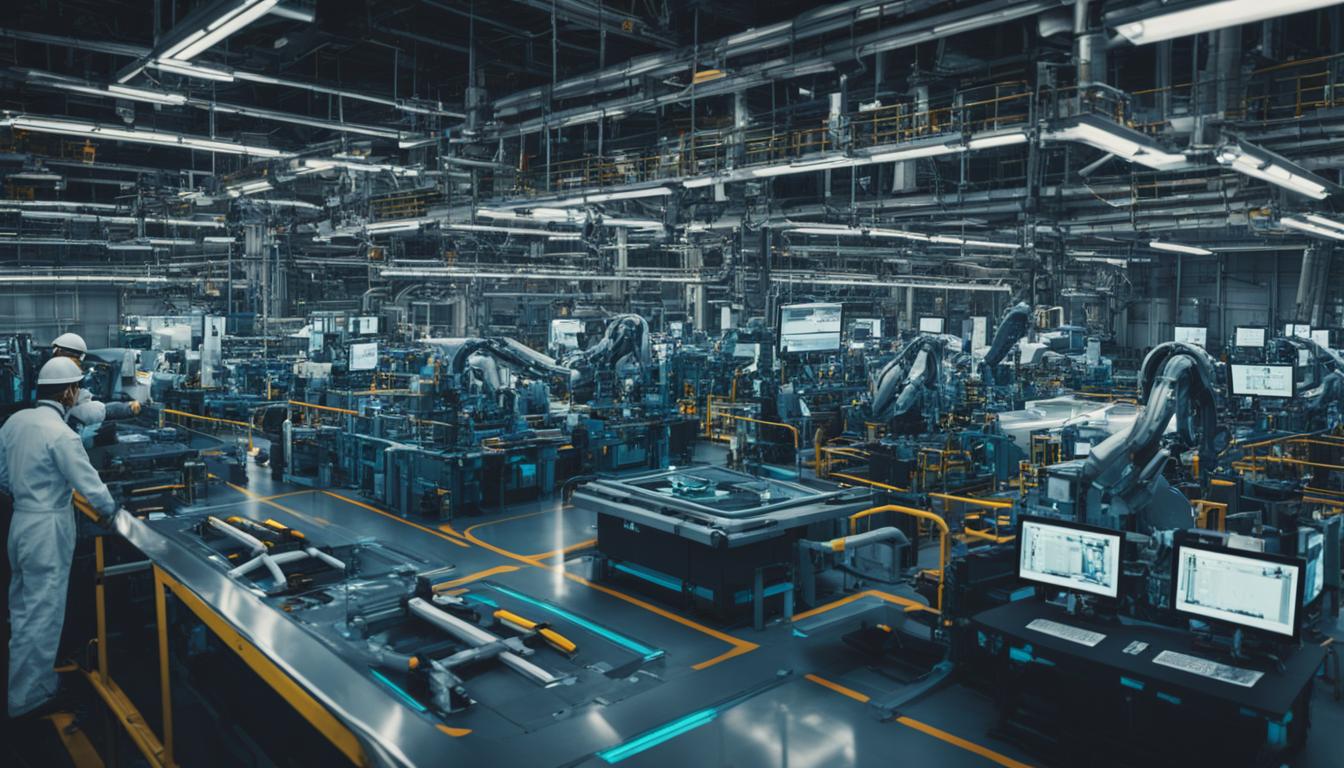Contents
- 1 How Augmented Reality Enhances Manufacturing Capabilities
- 2 Benefits of Using Augmented Reality in Manufacturing
- 3 Augmented Reality Use Cases in Automotive Manufacturing
- 4 Augmented Reality Use Cases in Aerospace & Defense Manufacturing
- 5 Conclusion
- 6 FAQ
- 6.1 How does augmented reality apply to the industry?
- 6.2 What are the benefits of using augmented reality in the industry?
- 6.3 How does augmented reality enhance manufacturing capabilities?
- 6.4 What are the applications of augmented reality in the automotive manufacturing industry?
- 6.5 How does augmented reality benefit the aerospace and defense manufacturing industry?
- 6.6 What is the future of augmented reality in the industrial sector?
- 7 Source Links
Introduction
Augmented reality (AR) is revolutionizing the industrial sector by enhancing efficiency, productivity, and safety. This technology combines digital and audiovisual elements to overlay virtual information onto the real world. Unlike virtual reality (VR), which immerses users in a completely virtual environment, AR improves the real world with virtual enhancements. In this article, we will explore the diverse applications of augmented reality in various industries and understand how it is transforming manufacturing processes.
Key Takeaways:
- AR improves efficiency, productivity, and safety in the industrial sector.
- AR overlays virtual information onto the real world.
- AR applications vary across different industries.
- AR is transforming manufacturing processes.
- AR has the potential to revolutionize the industrial sector.
How Augmented Reality Enhances Manufacturing Capabilities
Manufacturers are increasingly investing in augmented reality (AR) to enhance their manufacturing capabilities. AR allows for better human-machine collaboration, with the technology seamlessly integrating into the working environment. By using AR, manufacturers can track manual processes, identify inefficiencies, and optimize operations for increased productivity.
Research has shown that AR interfaces in manufacturing environments make interaction with robots more natural and intuitive. This technology enables manufacturers to collect data from manual processes, providing a broader picture of factory functionality and enabling them to address issues in real-time for improved efficiency.
Optimizing Human-Machine Collaboration with AR
One of the key advantages of using augmented reality in manufacturing is the optimization of human-machine collaboration. AR technology provides workers with real-time information, ensuring that they perform tasks accurately and efficiently. With AR interfaces, workers can access contextual information, instructions, and support directly in their field of view, eliminating the need to constantly switch between different devices or references.
“AR interfaces in manufacturing environments make interaction with robots more natural and intuitive.”
By seamlessly integrating AR into the manufacturing process, workers can perform their tasks with increased confidence and accuracy. This collaboration between humans and machines enhances overall productivity and quality control.
Optimizing Operations with AR Data
AR technology also enables manufacturers to collect valuable data from manual processes. By tracking and analyzing this data, manufacturers can identify bottlenecks, inefficiencies, and opportunities for improvement. This data-driven approach allows for continuous optimization of operations, leading to increased productivity and cost savings.
Moreover, AR provides real-time visibility into the manufacturing process, enabling quick decision-making and reducing downtime. Manufacturers can proactively address issues and make adjustments as necessary, minimizing disruptions and maximizing overall efficiency.
Improving Productivity with AR
One of the key benefits of using AR in manufacturing is its ability to improve productivity. AR interfaces can provide workers with step-by-step instructions, reducing the learning curve and ensuring consistent performance. This technology eliminates the need for extensive training and allows new personnel to quickly become proficient in their tasks.
Furthermore, AR can overlay digital information on physical objects, highlighting important details and guiding workers through complex tasks. This visual aid improves accuracy and efficiency, ultimately leading to higher productivity levels.
By harnessing the power of augmented reality, manufacturers can leverage human-machine collaboration, optimize operations, and improve productivity. The seamless integration of AR into the manufacturing process enhances overall efficiency and quality, revolutionizing the industry.
Benefits of Using Augmented Reality in Manufacturing
Augmented reality (AR) offers a wide range of benefits for the manufacturing industry. With its ability to merge digital information with the real world, AR solutions are transforming the way manufacturers operate, improving efficiency, productivity, and quality. Let’s explore some of the key advantages of using AR in manufacturing:
1. Training and Upskilling with AR
AR solutions provide an innovative and scalable approach to training and upskilling workers. By leveraging AR technology, manufacturers can create immersive and interactive training programs that adapt to the skill level of each individual. This ensures that workers receive customized and standardized training, leading to increased competence and productivity.
2. Digital Work Instructions with AR
AR enables the delivery of digital work instructions directly to workers’ field of view, eliminating the need for paper-based manuals or complex computer systems. With AR-guided instructions, workers can efficiently follow standardized processes, reducing errors and improving overall productivity. The visual and interactive nature of AR instructions enhances comprehension and ensures consistency in tasks performed.
3. Product Variation with AR
Product variation is a common challenge in manufacturing, requiring workers to adapt quickly to changes in assembly processes. AR simplifies this process by utilizing barcode recognition and automatic retrieval of the relevant work instructions. This enables workers to seamlessly access the necessary instructions for specific product variations, reducing errors and maintaining high-quality standards.
4. Quality Assurance with AR
AR technology allows for quick inspections at various steps of the manufacturing process, ensuring quality assurance. By overlaying digital information onto physical objects, AR enables workers to identify anomalies or deviations from specifications. This real-time feedback helps manufacturers address quality issues promptly, ultimately improving product quality and customer satisfaction.
5. Ergonomics with AR
AR enhances ergonomics in the manufacturing environment by customizing digital work instructions to meet individual needs. Workers can adjust the display of instructions to their comfort and work preferences. Additionally, AR provides multi-language support, enabling manufacturers to cater to diverse workforces and improve communication on the shop floor.
6. Manual Process Data and Analytics with AR
AR allows manufacturers to collect and analyze data from manual processes, providing valuable insights for optimizing operations. By capturing data in real-time, manufacturers gain a deeper understanding of production processes, identify bottlenecks, and implement targeted improvements. This data-driven approach enhances overall productivity and enables continuous process optimization.
“Augmented reality revolutionizes the manufacturing industry by providing innovative solutions for training, work instructions, quality assurance, ergonomics, and data analytics. By adopting AR technology, manufacturers can achieve higher efficiency, productivity, and quality standards.”
As manufacturers embrace the benefits of augmented reality, the industry is witnessing significant advancements. AR solutions for manufacturing have the potential to revolutionize the way products are made, ensuring safer, more efficient, and higher-quality production processes.
Next, we will explore specific use cases of augmented reality in automotive manufacturing, uncovering how this technology is transforming the assembly processes.
Augmented Reality Use Cases in Automotive Manufacturing
The automotive manufacturing industry is experiencing a transformational impact from Augmented Reality (AR) technology. With its ability to adapt to changes quickly, AR plays a crucial role in the assembly processes of the automotive industry. By utilizing AR, workers can benefit from precise guidance in placing components, reducing errors, and ensuring superior quality control throughout the assembly process. This technology revolutionizes the assembly of intricate parts by minimizing the time and cognitive load placed on workers, resulting in increased efficiency. Furthermore, the visualization capabilities of AR empower designers and technicians to interact with 3D models, enabling them to make impactful decisions during product design.
Augmented reality is revolutionizing automotive manufacturing by improving efficiency, reducing errors, and enhancing quality.
To illustrate the impact of AR in automotive manufacturing, refer to the table below:
| AR Use Cases in Automotive Manufacturing | Benefits |
|---|---|
| 1. Precise Component Placement | Minimizes errors and ensures quality control |
| 2. Assembly of Complex Parts | Reduces time and cognitive load on workers |
| 3. Visualization of 3D Models | Empowers designers and technicians to make informed decisions |
As automotive manufacturing continues to evolve, augmented reality is poised to underpin the advancements and improvements in this industry. With its remarkable ability to optimize assembly processes and enhance product design, AR is set to shape the future of automotive manufacturing.

Augmented Reality Use Cases in Aerospace & Defense Manufacturing
The aerospace and defense manufacturing industry can benefit significantly from augmented reality. Quality control is of utmost importance in this industry, and AR can provide accurate and efficient inspections to ensure product quality. By overlaying digital information onto physical objects, workers equipped with AR devices can view products from all angles and identify anomalies. AR also aids in maintaining compliance with industry standards and regulations. Additionally, augmented reality enables remote collaboration, allowing experts from different locations to review and work on issues together. This technology improves safety, enhances operational efficiency, and fosters innovation in the aerospace and defense manufacturing sector.
In the aerospace industry, augmented reality is being used for a wide range of applications. One such use case is in aircraft assembly, where AR is used to guide technicians through complex assembly processes. By overlaying digital instructions onto physical components, AR can ensure precise placement and reduce the risk of errors. This not only improves efficiency but also helps maintain the highest standards of quality in aircraft manufacturing.
Another crucial application of AR in aerospace manufacturing is in maintenance and repair operations. AR can provide technicians with real-time information and step-by-step instructions to assist in complex repairs. By visualizing virtual overlays on physical aircraft parts, AR helps technicians identify faulty components, reducing downtime and improving turnaround times.
Furthermore, augmented reality is also being utilized in training programs for aerospace and defense manufacturing. AR allows trainees to simulate real-world scenarios, providing a hands-on learning experience without the need for costly physical equipment. This not only enhances knowledge retention but also reduces the time and resources required for training.
Benefits of Augmented Reality in Aerospace & Defense Manufacturing
AR in aerospace and defense manufacturing offers numerous benefits:
- Improved quality control: AR inspections enable accurate identification of anomalies and ensure adherence to industry standards.
- Enhanced safety: AR helps identify potential hazards and provides real-time guidance, reducing the risk of accidents.
- Increased efficiency: AR assists technicians in complex assembly and repair processes, improving productivity.
- Cost savings: By reducing errors and streamlining operations, AR helps optimize resource utilization and minimize waste.
- Enhanced collaboration: AR enables remote experts to collaborate effectively, improving problem-solving capabilities.
Overall, augmented reality is transforming the aerospace and defense manufacturing industry by revolutionizing quality control, improving safety, and driving operational efficiency. As this technology continues to advance, we can expect further innovation and increased adoption in this sector.
| Applications of AR in Aerospace & Defense Manufacturing | Description |
|---|---|
| Aircraft Assembly | AR is used to guide technicians through complex assembly processes, ensuring precise placement and reducing errors. |
| Maintenance and Repair | AR provides real-time information and step-by-step instructions for technicians, assisting in complex repairs and reducing downtime. |
| Training Programs | AR simulates real-world scenarios, offering hands-on training experiences without the need for physical equipment. |
By leveraging augmented reality in aerospace and defense manufacturing, industry players can achieve higher quality standards, improved productivity, and a competitive edge in the market.

Conclusion
Augmented reality (AR) is revolutionizing the industrial sector, offering a wide range of applications and benefits in manufacturing. By enhancing collaboration between humans and machines, providing training and upskilling opportunities, improving quality control, and optimizing operations, AR is transforming the way manufacturers work.
Industries such as automotive and aerospace are already experiencing the positive impact of AR, with improved efficiency and productivity. But the potential of AR in the industrial sector goes beyond these examples. As technology continues to advance and more companies embrace AR solutions, we can expect even greater innovation and advancements in manufacturing processes.
The future of AR in manufacturing is incredibly promising. This technology has the power to revolutionize the industrial sector by streamlining processes, reducing errors, and enhancing overall productivity. As AR becomes more prevalent, we can anticipate significant advancements in areas such as human-machine interaction, training and upskilling, quality control, and data analytics.
In conclusion, augmented reality is reshaping the industrial sector, paving the way for a more efficient and productive future. By harnessing the potential of AR in manufacturing, businesses can stay ahead of the competition, drive innovation, and unlock new opportunities for growth in various industries.
FAQ
How does augmented reality apply to the industry?
Augmented reality enhances the industry by seamlessly integrating digital elements into the real world, improving efficiency, productivity, and safety in various industrial applications.
What are the benefits of using augmented reality in the industry?
Augmented reality offers benefits such as improved human-machine collaboration, standardized training and upskilling, optimized operations, enhanced quality control, and ergonomic customization.
How does augmented reality enhance manufacturing capabilities?
Augmented reality enhances manufacturing capabilities by tracking manual processes, identifying inefficiencies, optimizing operations, and making interaction with robots more natural and intuitive.
What are the applications of augmented reality in the automotive manufacturing industry?
Augmented reality in automotive manufacturing improves efficiency by guiding workers in precise component placement, enhancing assembly of complex parts, and aiding in product design decision-making.
How does augmented reality benefit the aerospace and defense manufacturing industry?
Augmented reality benefits the aerospace and defense manufacturing industry by providing accurate and efficient inspections for quality control, aiding compliance with industry standards, and enabling remote collaboration for issue resolution.
What is the future of augmented reality in the industrial sector?
Augmented reality has the potential to revolutionize manufacturing processes, drive innovation, and improve efficiency in various industries as technology advances and more companies embrace AR.




